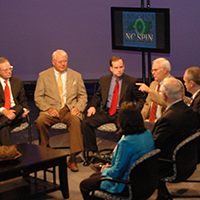Carolinians still make lots of stuff
Published May 16, 2025
By John Hood
You’ve heard it as often as I have: “We don’t make things here anymore.” It reflects the widespread belief that domestic manufacturing and other goods-producing industries have cratered since the implementation of the North American Free Trade Agreement (NAFTA) in the mid-1990s and China’s entry into the World Trade Organization in 2001.
It’s a myth. The output of American manufacturing is higher than ever, even after adjusting for inflation. In our state, manufacturing output in dollar terms is higher today than it was in the 1990s, though it remains a bit lower than it was before the Great Recession of 2007-09.
Why is the myth so prevalent? Because it’s readily apparent that some manufacturers have shrunk, or disappeared entirely, and that has sometimes been the result of competition from abroad. What’s not so readily apparent is that other manufacturers have grown or been birthed during the same period.
Moreover, there really has been a decline since the 1990s in manufacturing employment. In 1997, some 800,000 North Carolinians held manufacturing jobs. Today, that number is about 460,000. The primary story here isn’t foreign competition driving manufacturers out of business. It’s the use of automation and other technology to make our manufacturing more efficient — producing more goods per hour of labor.
We’ve been through this before with another goods-producing industry: agriculture. When my great-grandparents were born, they and most other North Carolinians were agricultural laborers, either running family farms or working for other enterprises that grew, harvested, or processed food and fiber. During the late 19th and early 20th centuries, as new machinery, seeds, fertilizers, and agriculture techniques proliferated, farmers came to produce vastly more output for each unit of input. Carolinians then migrated from farm labor to manufacturing, construction, retail, and other professions.
Last year, North Carolina’s agriculture and forestry sectors produced $7.4 billion in economic output. As far as I can determine, that’s higher than ever before. Of course, our state is much more populous and developed than it was a century ago. Agriculture makes up a smaller share of our gross domestic product — and a much smaller share of employment — not because it has atrophied but simply because other sectors and occupations have grown faster.
Manufacturing exhibits the same pattern. The sector produced $108 billion worth of goods in North Carolina last year. That’s 24% higher than in 1997, adjusted for inflation.
Now, the composition of the sector certainly changed. The dollar value of non-durable manufacturing is lower. But durable-goods manufacturing has more than made up the difference. In dollar value, North Carolinians produce far more machinery ($8.6 billion worth), computers and electronics ($7.4 billion), fabricated metal products ($5.2 billion), vehicles and auto parts ($3.4 billion), and other transportation equipment ($4.6 billion) than we do textiles and apparel ($2.6 billion).
North Carolina firms produced $2.4 billion worth of furniture and wood products in 2023. That’s down 34% since 1997. In the same year, 2023, North Carolina firms produced $28.9 billion worth of chemicals, plastics, and rubber products. These are vastly larger industries in our state, and have been either holding their own or growing over time.
More broadly, goods-producing sectors in North Carolina — agriculture, manufacturing, resource extraction, and construction — had a total output last year of $159 billion. That’s up 23% in real terms since 1997. Why might one think otherwise? Because the output of private services rose still faster, more than doubling to $548 billion (government services comprise the rest of GDP).
As our employment base shifted toward services, did we get poorer? Not at all. Personal income averaged $64,855 per North Carolinian in 2024, up 48% in inflation-adjusted terms since 1997.
I’m not saying everything is hunky-dory. Federal, state, and local regulations make it costlier than necessary to farm, manufacture, mine, and build. And too many North Carolinians lack the skills required to perform these tasks. That’s a telling fact, though: in goods-producing industries, our current challenge isn’t a labor surplus. It’s a labor shortage.
John Hood is a John Locke Foundation board member. His books Mountain Folk, Forest Folk, and Water Folk combine epic fantasy and American history.







